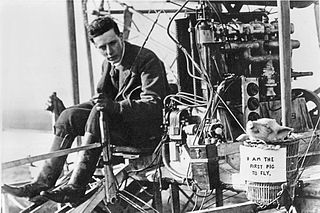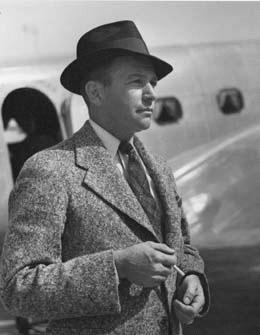
A fixed-wing aircraft is a heavier-than-air flying machine, such as an airplane, which is capable of flight using wings that generate lift caused by the aircraft's forward airspeed and the shape of the wings. Fixed-wing aircraft are distinct from rotary-wing aircraft, and ornithopters. The wings of a fixed-wing aircraft are not necessarily rigid; kites, hang gliders, variable-sweep wing aircraft and airplanes that use wing morphing are all examples of fixed-wing aircraft.

The Rutan Model 76 Voyager was the first aircraft to fly around the world without stopping or refueling. It was piloted by Dick Rutan and Jeana Yeager. The flight took off from Edwards Air Force Base's 15,000 foot runway in the Mojave Desert on December 14, 1986, and ended 9 days, 3 minutes and 44 seconds later on December 23, setting a flight endurance record. The aircraft flew westerly 26,366 statute miles at an average altitude of 11,000 feet (3,350 m).

Wingsuit flying is the sport of skydiving using a webbing-sleeved jumpsuit called a wingsuit to add webbed area to the diver's body and generate increased lift, which allows extended air time by gliding flight rather than just free falling. The modern wingsuit, first developed in the late 1990s, uses a pair of fabric membranes stretched flat between the arms and flanks/thighs to imitate an airfoil, and often also between the legs to function as a tail and allow some aerial steering.
This is a list of aviation-related events from 1931:
This is a list of aviation-related events from 1927:
This is a list of aviation-related events from 1910:
This is a list of aviation-related events from 1961:

This is a list of aviation-related events from 1909:

Albert Scott Crossfield was an American naval officer and test pilot. In 1953, he became the first pilot to fly at twice the speed of sound. Crossfield was the first of twelve pilots who flew the North American X-15, an experimental spaceplane jointly operated by the United States Air Force and NASA.

A paper plane is a toy aircraft, usually a glider made out of single folded sheet of paper or paperboard. A simple nose-heavy paper plane, thrown like a dart, is also known as a paper dart.

An airplane or aeroplane is a fixed-wing aircraft that is propelled forward by thrust from a jet engine, propeller, or rocket engine. Airplanes come in a variety of sizes, shapes, and wing configurations. The broad spectrum of uses for airplanes includes recreation, transportation of goods and people, military, and research. Worldwide, commercial aviation transports more than four billion passengers annually on airliners and transports more than 200 billion tonne-kilometers of cargo annually, which is less than 1% of the world's cargo movement. Most airplanes are flown by a pilot on board the aircraft, but some are designed to be remotely or computer-controlled such as drones.

Clyde Edward Pangborn, nicknamed "Upside-Down Pangborn", was an American aviator and barnstormer who performed aerial stunts in the 1920s for the Gates Flying Circus. He was its half-owner, chief pilot and operating manager, working in partnership with Ivan R. Gates. In 1931, Pangborn and co-pilot Hugh Herndon Jr. flew their plane, Miss Veedol, on the first non-stop flight across the Pacific Ocean.

Calbraith Perry Rodgers was an American aviation pioneer. He made the first transcontinental airplane flight across the U.S. from September 17, 1911, to November 5, 1911, with dozens of stops, both intentional and accidental. The feat made him a national celebrity, but he was killed in a crash a few months later at an exhibition in California.

Solar Impulse is a Swiss long-range experimental solar-powered aircraft project, and also the name of the project's two operational aircraft. The privately financed project is led by Swiss engineer and businessman André Borschberg and Swiss psychiatrist and balloonist Bertrand Piccard, who co-piloted Breitling Orbiter 3, the first balloon to circle the world non-stop. The Solar Impulse project's goals were to make the first circumnavigation of the Earth by a piloted fixed-wing aircraft using only solar power and to bring attention to clean technologies.

Lowell Herbert Smith was a pioneer American airman who piloted the first airplane to receive a complete mid-air refueling on June 27, 1923, and later set an endurance record of 37 hours on August 28, both in a De Havilland DH-4B. Smith also piloted the Douglas World Cruiser Chicago, which along with one other made the first aerial circumnavigation in 1924. Smith held 16 records for military aircraft in speed, endurance and distance. He was awarded the best achievement in flight Mackay Trophy twice.

John F. Kennedy Jr., the son and namesake of the former U.S. President John F. Kennedy, died when the light aircraft he was flying crashed into the Atlantic Ocean off Martha's Vineyard, Massachusetts, on July 16, 1999. Kennedy's wife Carolyn Bessette and sister-in-law Lauren Bessette were also on board and died. The Piper Saratoga departed from New Jersey's Essex County Airport; its intended route was along the coastline of Connecticut and across Rhode Island Sound to Martha's Vineyard Airport.

A human-powered aircraft (HPA) is an aircraft belonging to the class of vehicles known as human-powered transport.

André Borschberg FRSGS is a Swiss entrepreneur, explorer, pilot, and speaker. He is the co-founder of the Solar Impulse project, the first ever round-the-world solar flight, successfully completed in July 2016. During the Japan-to-Hawaii leg, André broke the world record for longest solo flight in an airplane of any kind: 117 hours and 52 minutes, breaking Steve Fossett's 2006 record. Before that, on 7 July 2010, André completed the first 24-hour solar-powered flight. The flight set records for the longest manned solar-powered flight and the greatest height reached by a manned solar aircraft.
Charles Keeney Hamilton was an American pioneer aviator nicknamed the "crazy man of the air". He was, in the words of the U.S. Centennial of Flight Commission, "known for his dangerous dives, spectacular crashes, extensive reconstructive surgeries, and ever present cigarette" and was "frequently drunk". He survived more than 60 crashes.














